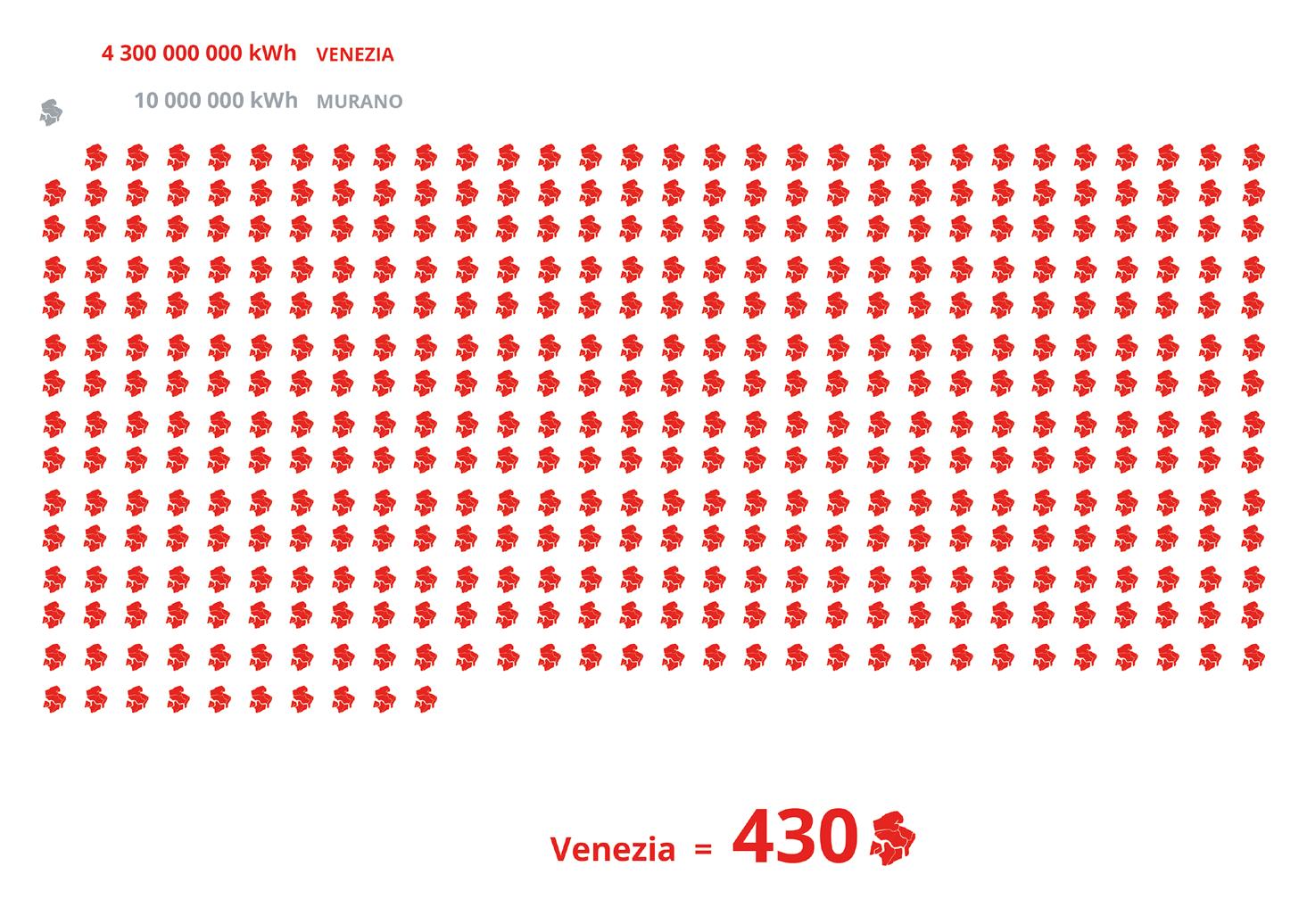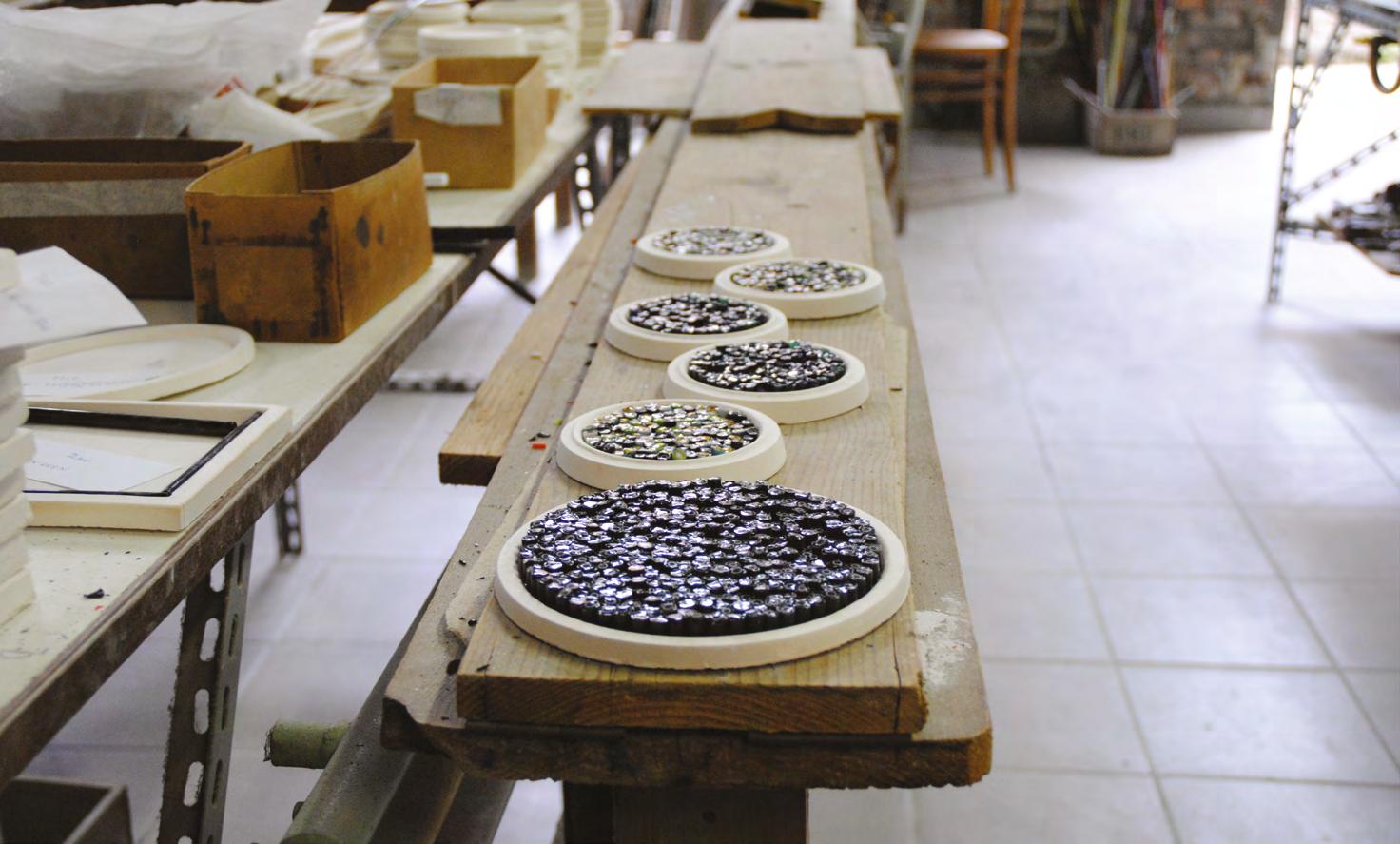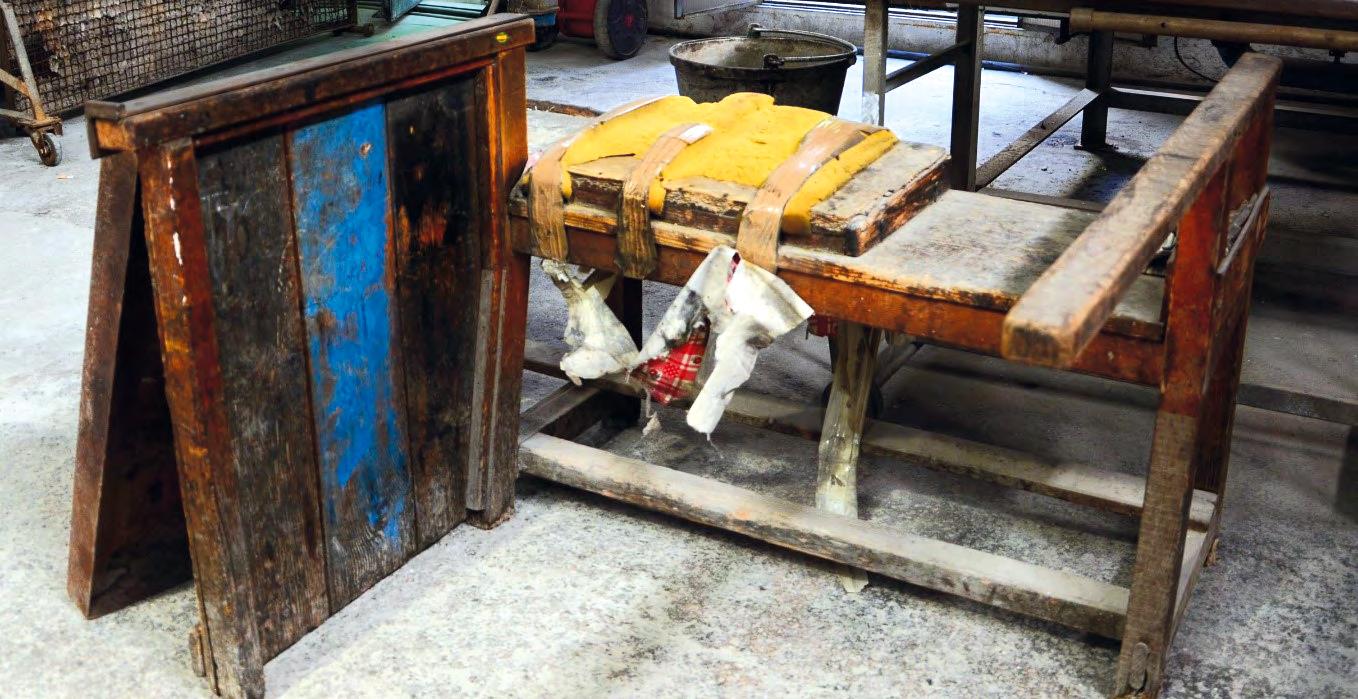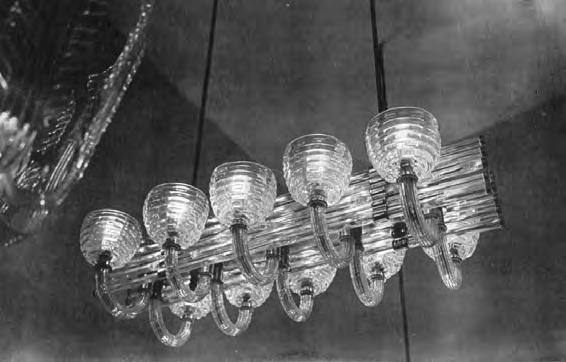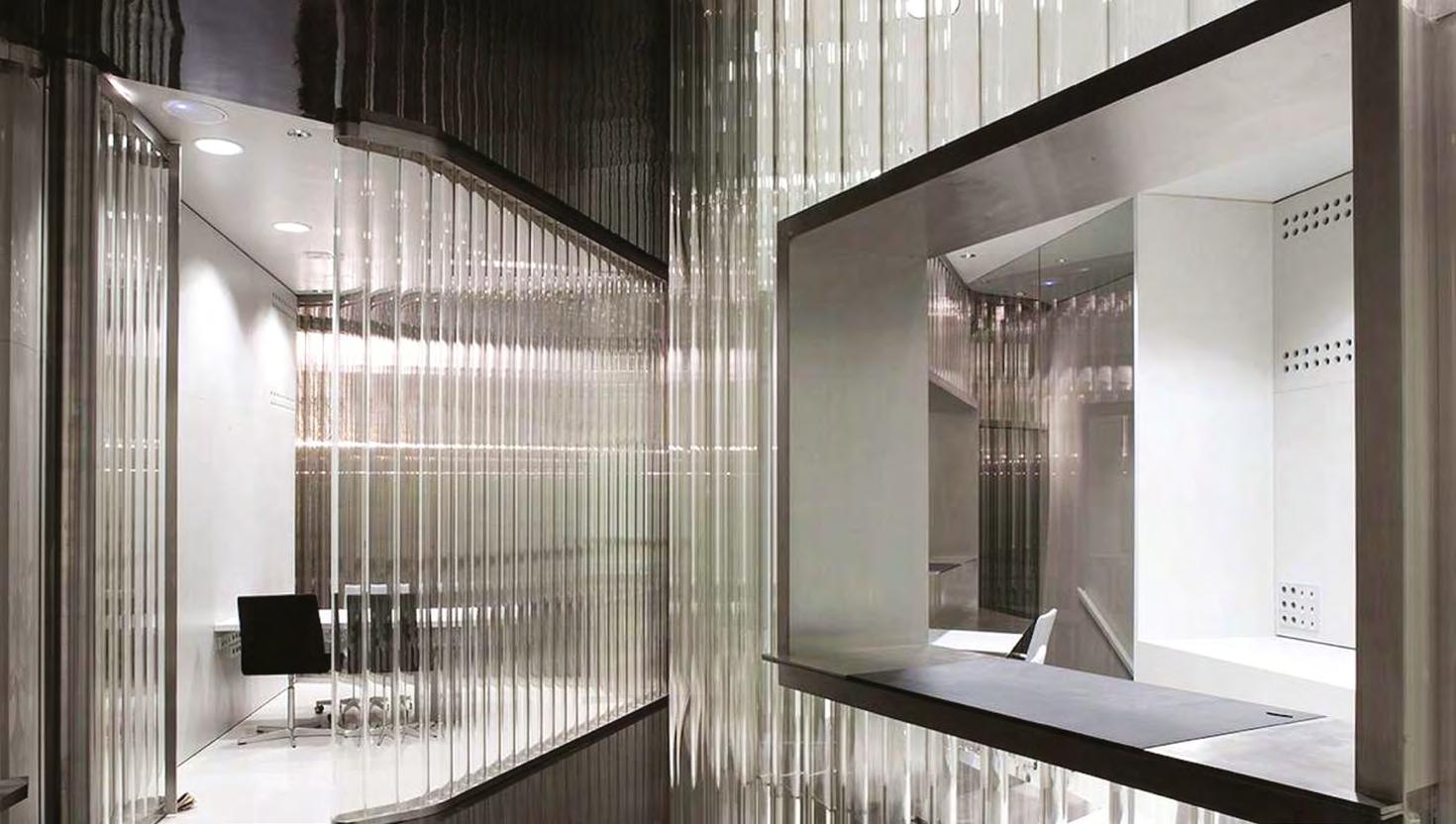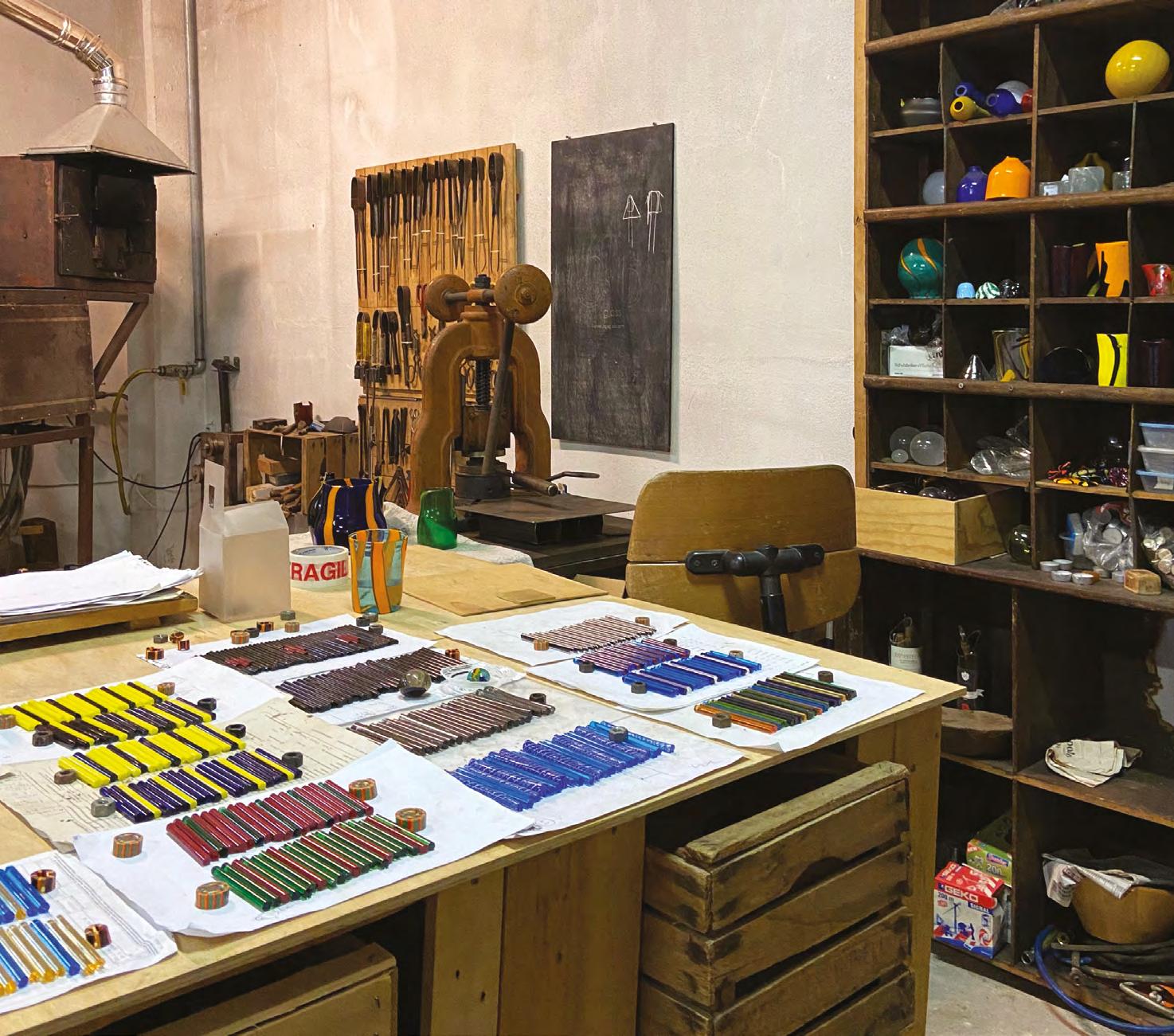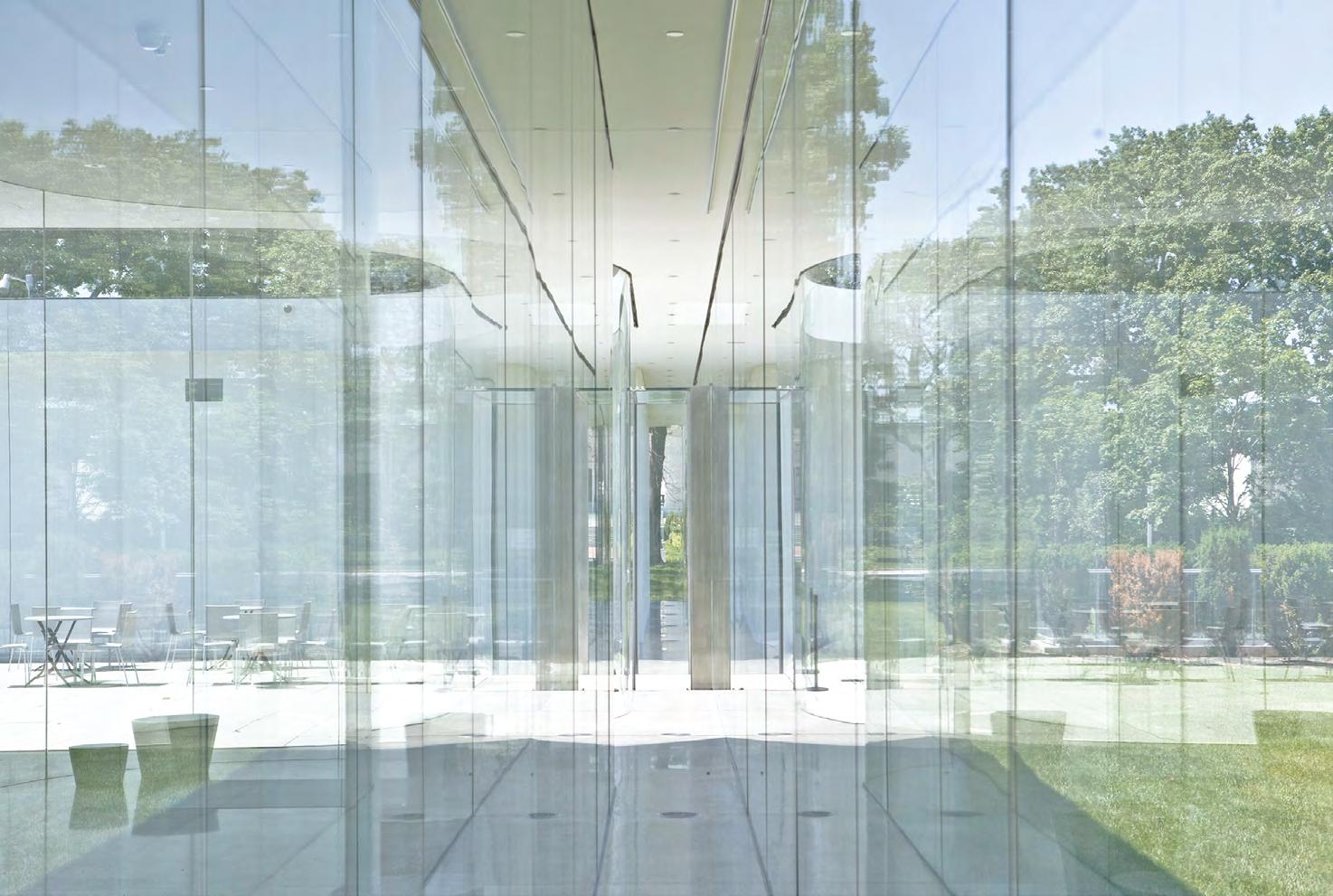
21 minute read
Apparent divide. An observation of the handmade and the machine-made through the work of Laura de Santillana
LAURA PANCHAUD
KEYWORDS: LAURA DE SANTILLANA, PRODUCTION PROCESS, GLASSMAKING
This paper examines the apparent opposition between the handmade and the machine-made through the work of artist Laura de Santillana (1955-2019). Departing from her work as a designer, she developed a distinctive and innovative practice, creating works in Murano, in the US and, after 2013, in the Czech Republic. Her Czech work marked a turning point in her career, exploring a new production process: “slumping” glass. While in Murano her works were handblown and shaped by a master glassmaker. In The Czech Republic this “hand” was replaced by a “machine”, and the glassmaker by an engineer. These separate locations become representative of the two poles of “manual production” and “industrial production”. This case study explores this shift, and the differences between both ways of making, by examining de Santillana’s working process and oeuvre. In oscillating continuously between both worlds her work offers a way to bridge the apparent divide.
Introduction
The apparent divide between the handmade and the machine-made
The work of Laura de Santillana (LdS) is an interesting case within which to consider the utility of the binary divisions of machine-made and handmade, industrial and craft. The machine and the human hand represent contradictory values. This becomes a particularly interesting question in the field of glassmaking, where these categories seem especially persistent. The master glassmaker in Murano shapes his object by working freehand without the aid of technology. It takes years of experience to gain mastery of the necessary skills. Even though a particular process might be repeated, every object that results remains unique, carrying the trace of the maker’s hand. The idea of the machine-made, a process that ideally results in perfect replication, seems diametrically opposed to this model of production. The work of Laura de Santillana, however, meanders between these two poles, dissolving this opposition. Close study of her working processes throws the utility of these distinctions into question, especially in the field of glassmaking.
Laura de Santillana’s formative years
De Santillana’s training and background are important in understanding her work. Born in Venice, she was the granddaughter of Paolo Venini, founder of the Venini glassworks in Murano, which after his death was taken over by Laura’s father Ludovico Diaz de Santillana. She grew up in this environment and joined the family business as a designer in 1975 after training in graphic design with Lella and Massimo Vignelli in New York. From 1989 to 1993 Laura de Santillana was the creative director of EOS, a new glass brand that was founded by the Santillana-Venini family following their ouster from the Venini company in 1986. For a few years she worked as an independent designer for companies such as Rosenthal, Arcade, Salviati and private commissions. After these first experiences as a designer she decided to take an artistic path and subsequently worked as a designer only on rare occasions.
Everything de Santillana learned in these formative years would manifest itself in her artistic practice. She developed a deep understanding of the material of glass and how to manipulate it. Spending every day within the Venini factory she was immersed in all the facets of that business – the evolution of a design from the first prototype to the finalized object that must fulfill the highest standards. Every object had to be perfect in terms of shape, proportions and colour, and underwent a very strict quality control check before leaving the factory. The company culture placed an enormous importance to the on-going experimentation process between the designer and the maker which led to innovations that were the company’s calling cards, and which were revealed with fanfare during tradefairs. Working by her father’s side, she oversaw numerous talented designers who came to
work at the factory and helped to adjust their projects to the specific material requirements of glassmaking. During these years she learned everything about colors, which at Venini held a particular importance, as well as how to navigate the relationship with a master glassmaker. This rich and varied experience in glassmaking enabled her to become an exacting partner in the design process, but one who also understood how much the work relied on the knowledge and mastery of the maker. During her artistic career she would eventually work exclusively with one master glassmaker with whom she established a unique relationship over the course of 20 years of collaboration. During her time at Venini and EOS, numerous designs by Laura de Santillana went into production, proof of her capacity to create objects in glass that were suited for industrial production and are in line with the industrial object. The case of glassblowing is particular, because even the industrial object is unique, forcing de Santillana to consider material variation in her designs and how factors such as economy affect the end result. This idea of reproduction and repetition gives rise to LdS’ philosophy of the object in a state of repetition, an idea that will become one of the key aspects of her artistic practice.
In an interview conducted by her partner, Gianlugi Calderone, who is a filmmaker, de Santillana names three men who have had a significant influence on her (Calderone and De Santillana, 2009). The first is her father Ludovico Diaz de Santillana, an architect. The second is her grandfather, Giorgio de Santillana, a scientist-philosopher who worked as a professor at the Massachusetts Institute of Technology. From him she acquired the need to measure and the impulse to create order to gain analytic understanding. The third is the designer Massimo Vignelli, who taught de Santillana the discipline of precision (De Santillana and Bethenod, 2014). It is interesting to see LdS synthesize these three professions of architect, scientist, and designer as we begin to look at her artistic practice.
Laura de Santillana’s artistic practice
This background surely gave rise to Santillana’s preoccupation with the idea of industrial production as a repeated process that nonetheless resulted in a unique piece, the work of art. In 1999, a flat shape appeared in her work, resulting from the compression of a bubble of glass. She repeated this process over and over, creating a series that at first seem like an endless repetition of the same form, yet in which every piece is unique at a closer look (Figure 01 and 02). Recognizing the endless possibilities held by this object, it would become the iconic form of LdS’s work, giving her enormous freedom to experiment. This flattened form acted almost like a canvas that permitted de Santillana to investigate colour, techniques or the simple gesture of cutting open the hot glass. It is through repetition that de Santillana conducted her research. In the same documentary (Calderone, 2019) she explains that she is more interested


Fig. 01 C7 (2001), 50 x 44 x 5 cm. F. Zonta, courtesy of The De Santillana Foundation Fig. 02 Series C1-C7 (2001). F. Zonta, courtesy of The De Santillana Foundation Fig. 03 Tokyo-Ga (2017), 30.5 x 22 x 4.5 cm. F. Zonta, courtesy of The De Santillana Foundation
in the procedure than the end result. In her work she becomes the designer of a process that hands to the maker a set of instructions as a “framework for composition and improvisation” (De Santillana, 2001). In her working notes “Ragas”1 she explains that it is through seeing the work materialize that she understands how to proceed and why she should take a particular direction next. In an interview De Santillana (2014) says: “It’s the idea of a field, an enclosed, fixed, regulated, environment, inside which you can move about freely, like my own flat rectangular forms, within whose framework everything is possible, where things can follow any kind of organic development, staying always inside precise spatial boundaries. In an ongoing dialogue and through a process of constant evolution, she and the maker learn to master the process she designs until it is refined more and more specifically. The artwork becomes part of a greater whole, a sequence, whereby each iteration explains the next (De Santillana, 2001). Her work was most often produced as part of a series making each individual piece part of an ongoig project of research. In the case of the Tokyo-Gas (1999-2019) (Figure 03) or the Flags (1999-2016), for example, the subject of this exploration was the pairing of colors, which changed as she progressed through the series. In this continuous dialogue with the making process, she broke with traditional ways of making and transported the material of glass to places it had not yet been.
From 2013 onwards, parallel to her work in Murano and to her production the United States, which took place on and off from 1986, Laura de Santillana started to produce work in the Czech Republic. There, she opened a new chapter of creative intervention through a completely new process “slumping” glass. Shapes were first blown into a mold, and then collapse inside an enormous kiln that was programmed by an engineer. Again, she became a designer of a process of making, handing over a set of instructions to a third
1 Raga is a melodic framework for improvisation in Indian music.
party. Only this time, she found herself in dialogue with a machine that was programmed by an engineer. This shift from the “hand” to the “machine” is concurrent with the shift between her two main sites of production: the hand in Murano and the “machine” in the Czech Republic. Through this lens, the making the work of Laura de Santillana becomes an interesting case study to observe the evolution in her making process of two very different ways of working the material of glass, that of being in a dialogue with a master glassmaker in Murano versus the Czech process in which the role of the master glassmaker was replaced by an engineer.
This touches upon an interesting definitional question: Does the role of the designer/artist changed by this change of mediator? How is the artwork itself affected by this? With these questions in mind, we should return to LdS’ work itself. The objects produced in each place can further an investigation of what the consequences were of these shifts of location and practice, beginning with her work in Murano, and then turning to the “machine-made” work in the Czech Republic.
Laura de Santillana’s work in Murano
Creating works in Murano through the free hand of a craftsman might have been the most natural way for Laura de Santillana to work. Having trained as a designer in a glass factory, she internalized the principle that while the designer might not touch the glass, their role was to steer the glassmaker’s hand as if an extension of the designer’s own. In the film La foglia d’oro (Calderone, 2019) she explained that she considered making something with her own hands, even a drawing, private. Her public, artistic work needed to be mediated by something else. Working in Murano, this intermediary was the master glassmaker. She says,: “Il maestro soffiatore, con la sua secolare esperienza e maestria, al quale si sottoponeva un disegno e che veniva seguito ed indirizzato durante il percorso della realizzazione dell’opera…” Her role was to accompany and instruct the master glassmaker. In doing so, she became an “active observer” who indirectly, through the hands of somebody else, intervened in the material. The master glassmaker, with their training and experience, was an essential part of her artistic practice. In an interview with M. Bethenod, De Santillana explains that delegation and the idea of distance were important aspects in her practice (De Santillana and Bethenod, 2014). Such distance crucially allowed for events that were outside her control. Rather than dividing the realization of the work between a pre-meditated design and a craftsman’s execution, Santillana saw glassmaking as malleable, open to modifications to the design throughout the entire process. This became an important aspect of Laura’s work: as she partially moved away from designing a finalized object, she became instead the designer of a process within which chance could intervene.
Laura’s collaboration with Simone Cenedese, the master glassmaker she eventually would work with exclusively in Murano, started in the 90’s and lasted until the end of her artistic career. Instead of a finalized drawing, Laura would hand over to Simone a set of instructions, which usually included the amount of glass, the dimension of length and the width, and the sequence of colors to be used. This set of instructions are documented meticulously inside a socalled furnace book LdeS would bring with her during every work session. The book helped her to remember the process of making every individual piece, as she included information such as the date, dimensions, sequencer of colors, and any other observations that arose during the making process. These notes came to serve as a kind of formula that LdeS used to standardize the process of each series of works. By varying the determined parameters of her formula she obtained variety in her results. She thus approached her work with the mindset of a scientist, more preoccupied with the scope of her overall procedures, sets of controls and variables, than the outcome of each individual work. It was not the unique piece but the process in which it was embedded that was important to her. Simone executed these sets of instructions given by LdeS under her close observation and guidance. After years of experience in working together almost no words were necessary, since the slightest gesture by Laura was understood by Simone. One might think that this endless repetition of the same sequence would have become boring to a skilled craftsman, but the opposite seems to have happened, as Simone explains in a film by Gianluigi Calderone that documented the relationship between de Santillana and her master glassmaker. Even though the work steps repeated themselves there was always something new in the process. The work was a continuous and long evolution, he says in the film, mutating bit by bit. Development occurred through dialogue with the maestro. He describes a sense of complicity in the experimentation between the designer/artist and the maker. Working with LdS was technically challenging (Calderone, 2019). Her ideas guided his making in a given direction but his execution might bring forward a result LdeS was not able to foresee. What first might have seemed like an accident could easily turn into a discovery that changed the course of the project. This moment of confrontation and dialogue between the designer/artist and the maker during this process was crucial for the evolution of the work. De Santillana’s work remains beautiful evidence of this slow and steady evolution that investigated endless possibilities.
Her work in Murano demonstrates how Santillana applied industrial notions to the unique object, that is, the work of art. The seemingly repeated object carried vestiges of the manual process of creation. The standardization of each process carved out a “window of chance” that made every piece unique. In fact, it is the repetition that visually underlines the uniqueness of every individual piece. In her work, Santillana is able to correlate opposing ideas, such as “standard and unique”, “order and chaos”, “intent and chance” creating a set of hybrid processes.
Laura de Santillana’s work in the Czech Republic
In 2013 Laura de Santillana visited the Czech Republic to explore producing some work there. Originally attracted by uranium glass2, which was no longer available in Murano, and an initial interest in casting, she visited various factories with the help of her friend and technical advisor Charles Parriott. What started as a simple experiment in slumping a small piece in uranium glass (Figure 04) turned into an on-going research that de Santillana pursued until her death in 2019.
After years of experience with glassblowing she found herself working with an engineer who programmed a machine. It was no longer the glassblower’s hand but the engineer’s algorithm that shaped the material and became Laura de Santillana’s mediator in her working process. In this new situation Laura de Santillana described her intention: “Provo a dare una forma razionale ad un complesso di azioni e reazioni diverse che compongono, sinora, il complesso percorso iniziato in questo nuovo progetto che chiamo “boemo” e che si sviluppa intorno ad una nuova tecnica, mai affrontata precedentemente da me, (ne’ forse da altri)”. This new making process described above was divided into two phases. In the first step, cylinders were made by blowing glass into a mold. According to LdS, this first phase was a fairly simple procedure. As she explained: “è stato in questo caso ridotto ad un semplice maestro soffiatore, che poteva indifferentemente essere sostituito da una macchina”. In a second step, these blown cylinders were placed inside an enormous kiln where they slowly collapsed on top of a mold under the guidance of an programmed heating and cooling cycle (Figure 05). It was at this particular moment the object took its final shape. Every cycle was accompanied by a series of checks at the various temperature stages. This allowed the artist to have an understanding of what was going on inside the kiln and to instruct the engineer accordingly as to whether the temperature should be increased or if he should start the cooling process. In this way, the artist participated in the process.
Again, LdeS, as the designer of a process, handed over a set of instructions to the maker that shaped the material. Here, these instructions were comprised of the dimension and colour sequence of the cylinder to be collapsed, the type of mold and its exact position (inclination), and the maximum temperature of every cycle. She learned to control and modify the environment within the “machine” in such a way that she could shape the material without touching it. In an attempt to gain more and more control over the process and to identify areas that she could manipulate she brought manual work into the industrial process and confronted the machine like a craftsman. LdS describes her relationship to this change and how it affected her act of creation in the next part of her earlier quote about her relationship to the master glassworker, describing how the creative moment shifts: “...il
2 Glass colored with uranium oxide.
momento creativo che risiedeva nelle sue mani si è trasferito in un ingegnere che deve programmare un ciclo di riscaldamento e successive raffreddamento del vetro dal quale vien fuori l’opera”.
The creative moment thus became an event happening behind closed doors. Only through punctual checks was de Santillana able to see what was occurring inside the kiln to give instructions to the engineer. Like in Murano she was present and gave instructions as to how to proceed during the making. She decided when the maximum temperature had been achieved, when the cycle should come to an end and the cooling process should start. As natural as the work appears, in its irregular, melted forms,the process she designed was very complex. In fact, she explained: “Questo nuovo “maestro”, in realtà, non è ancora nato perché il processo attraverso cui si possa formare l’esperienza necessaria a sapere quali sono gli interventi necessari durante questo ciclo è molto costosa, e l’intenzionalità e la formazione artistica di questi ingegneri è pressappoco vicina allo zero”. De Santillana studied every cycle after it was done to understand the parameters she could adjust to gain more and more control over the process. Even though LdS greatly enjoyed the scientific dimension of the making, as she said “We’re discussing only viscosity, temperature, gravity, as if it were a scientific experiment: We’re going to try this thickness, that temperature, we’re going up to 750º over 20 minutes instead of 10” (De Santillana and Bethenod, 2014, p. 124) she also mentioned the lack of a common language on aesthetical terms. She approached the engineer in Bohemia like a craftsman, demanding a level of detail and precision the workshop wasn’t used to, and at times was not able to provide. Her records show that on multiple occasions she tried to obtain better control over colour in terms of intensity and overlays, even trying to create her own new colours. Similar attempts can be found related to the shapes of her cylinder works in terms of thickness and preparatory work prior to the slumping process. She persisted in identifying procedures and formulating standards and protocols that would allow her to exert the high degree of control over the process that she desired.



Fig. 04 One of the first slumped pieces in uranium glass (2013). Courtesy of The De Santillana Foundation Fig. 05 Experiments after slumping process inside the kiln (2019). Courtesy of The De Santillana Foundation Fig. 06 Various typologies of slumped glass arranged by LdS (2015). Courtesy of The De Santillana Foundation
This evolution can be seen in her work, which demonstrates how steadily, not only more precision and control was obtained, but also heightened complexity. In the Czech context, her work remained of a sequence of experiments, in which each object set the terms for the next. She moved from collapsing one element to two elements in 2016 in the I Fedeli/Twin series (Figure 7) and added yet another variable when she included three cylinders in the 2019 series Triplet (Figure 8). Despite this new way of making, mediating a kiln based on trial and error, the works produced by de Santillana have the visual feel of a natural evolution. They become pure matter, as if de Santillana hands over more space to the material itself and through her process invites it to perform. Almost effortlessly, the material melts into a freestanding position, recalling a glass screen. Just like her work in Murano, these works carry the traces of making and attest the moment of creation orchestrated by de Santillana. In her sets of directions, de Santillana listened without dominating the material by carefully studying its behavior after every experiment. Years of experience in navigating somebody else’s hand made LdS an excellent observer during the process of making. She understood what she could interfere to steer the process in the desired direction. With the care and diligence of a craftsman de Santillana puts in meticulous work to modify the environment inside the machine in such a scientific and specific manner that she shapes the material without touching it.
Conclusion
The work of Laura de Santillana throws into question the binary divisions of machine-made and handmade, industrial and craft. The two centers of de Santillana’s production become the two sites of this opposition. And yet de Santillana’s working practices moved fluidly between the two in an unorthodox manner. In fact, by transferring the elements of one form of making into another, for example the individuation of handmade glass into the iterated forms of her “slumped”pieces, her work becomes a hybrid. This fusion challenges the notion of such a separation, as they become intrinsically interrelated. In her work, the specific material exigencies of glasswork serve to undermine the idea of such absolute categories in ways that extend beyond the field of glass itself. For years, De Santillana conduit to the material process had been a master glassmaker. Her work produced in the Czech Republic demonstrates how this experience might have translated when she found herself intervening in an industrial process. Thanks to her particular training as a designer inside the context of a glass furnace, she was able to work with both the handmade and the industrial equally.
According to Moravánszky, “Concept and material are engaged in a constant process of transformation in which material, craftsman, worker, technician, machine, image and meaning determine and influence each other” (Moravánszky, 2018, p. 12). The work created in both centers of productions is evidence of a slow and continuous dialogue between de Santillana and
Fig. 07 Untitled (2017) from the I Fedeli/Twin series, 122 x 41 x 14 cm. F. Allegretto, courtesy of The De Santillana Foundation Fig. 08 Untitled (2019) from the Triplet series, 118 x 48.5 x 28 cm. F. Allegretto, courtesy of The De Santillana Foundation
the maker that stipulates an evolution in the way of making. This on-going exchange between a technical understanding and knowhow from the maker, and an innovative vision of the material from the designer/artist is the motor that can lead towards development of new techniques. Laura’s work shows how blending notions from handiwork and industrial manufacturing processes can have fascinating results, wedding traditional skills to the possibilities offered by digital technologies to develop hybrid forms. De Santillana revealed the possibilities inherent in the traditional way of doing things and built upon the Murano tradition, incorporating new technical investigations of practice and design. Her working model offers a way of keeping tradition alive, by reimagining it and embedding it in the spirit of the contemporary. She bridges an apparent divide, where the separation line of an opposition becomes blurry and transgressive, resembling the encounter of two colours in her Tokyo-Ga.
As a model for how such hybrid forms might produce new results, de Santillana’s work remains open. Since the artist’s death, her estate, in collaboration with the Pentagram Siftung, has been in the process of cataloguing the artist’s archive in order to make it available for further study. As her materials become available in the near future, scholars and artists will be able to draw on LdS’s rich body of work, perhaps continuing her explorations of process under new parameters. I would like to express my gratitude towards Laura de Santillana and the estate that represents the artist today to enable this reflection in the form of a case study.
References
Calderone, G. (Director). (2019). La foglia d’oro. Film at Le stanze del Vetro. Calderone, G., De Santillana, L. (2009). 3 Visions in Glass (Exhibition Catalogue). Stuttgart: Arnoldsche. De Santillana, L. (2001). Works (Exhibition Catalogue). Cinisello Balsamo: Silvana Editoriale. De Santillana, L., Bethenod, M. (2014). I Santillana: works by Laura de Santillana and Alessandro Diaz de Santillana. Milano: Skira. Moravánszky, Á. (2018). Metamorphism. Material Change in architecture. Basel: Birkhäuser.

